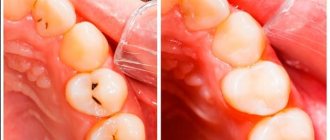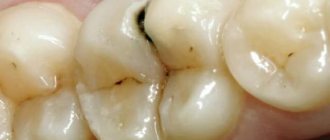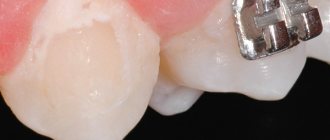Modern dentistry has a large arsenal of high-quality materials for filling teeth. What kind of filling should I put in order to reliably preserve the dental crown from destruction - plastic or ceramic, silicate or cement, chemical or light? Let's take a closer look at the different types of filling material and answer the question which filling is better.
Popular dental materials
Fillings are divided into permanent and temporary. A permanent one is placed when there is minor damage to the tooth crown, a temporary one is used for long-term complex treatment or diagnostics. A temporary filling is also used to protect medicinal compounds during dental treatment: a medicinal compound is placed under it.
The materials from which fillings are made are divided into several types:
- cement, silicate;
- plastic;
- metal, amalgam;
- ceramics;
- composites.
Depending on the material used, fillings are divided into several main types:
- cement;
- composite;
- compomers.
The dental industry also produces other types of fillings - plastic, metal and ceramic.
The most durable material is made from light-curing composite. Such fillings are expensive, but the high price justifies the long service life. The fillings look aesthetically pleasing and have the ability to change their shade with changes in lighting.
The most popular material is dental cement. These fillings are still in demand among patients due to their low cost, high adhesion and strength. The fillings literally stick to the surface of the crown and do not form air gaps.
How long does a temporary filling last?
Many patients are interested in how long can they walk with a temporary filling? Can it at least temporarily replace a permanent one, which costs more and requires another visit to the doctor?
Temporary tabs are different. This will determine how much it costs. The most short-lived ones isolate the oral cavity from arsenic, which is embedded in the pulp of the tooth. Typically, such treatment lasts for 2-3 days, and then it is necessary to change the temporary material to permanent one.
The service life of a temporary filling in the treatment of canals or periodontitis is slightly longer. You can use it for up to 2 months until inflammation and infection are completely eliminated. The doctor monitors the process using radiovisiography, a safe diagnostic method that has replaced x-rays in dental clinics.
A separate question is how many days a temporary filling is placed for prosthetics with massive non-removable structures? It all depends on the volume of work and timing, however, in most cases, temporary material will last the patient no more than a year.
If a patient has a temporary filling, how long after can he eat food so that it does not fall out? Usually you can eat it almost immediately, but it is worth remembering that temporary materials are very unreliable, so they can crumble and crumble under intense pressure on the tooth. This is normal and should not be a cause for concern.
Cement materials
Cement differs significantly from composite in its lower hardness, however, it is able to protect the tooth from repeated carious development. A disadvantage is the high density of cement compared to tooth tissue: over time, this contributes to the thinning of the crown surface adjacent to the filling.
Cement compositions have three subtypes, according to additives to the main ingredient:
- silicate;
- phosphate;
- glass ionomer.
Silicate compounds are the oldest of all. The material contains special glass mixed with phosphoric acids. The silicate composition has a different release of fluoride, which prevents the development of dental caries. The harmfulness of the material lies in its aggressive phosphoric acid, which destroys the pulp. To neutralize the effect of acid on the pulp tissue, a special gasket made of safe substances was installed.
Phosphate compounds are characterized by fragility and fragility, weak adhesion (adhesion to tooth tissue), and high abrasion. The peculiarity of these fillings is their high toxicity, which provokes the proliferation of aggressive bacteria. This substance (phosphate) does not protect well against the re-development of caries.
Glass ionomer cement is used to treat children. The substance is as close in texture as possible to dental tissue, has high adhesive characteristics and safety. The glass ionomer is illuminated with a special ultraviolet lamp, which promotes rapid hardening of the material and high-quality tooth protection from infection. The advantages of this material include the fluoride contained in the composition, which protects against the development of recurrent caries.
The disadvantages include fragility - softness and instability of the composition. In modern dentistry, strengthened glass ionomer is used, the composition of which is supplemented with metal or ceramic particles. This material is used for filling chewing molars; it is most resistant to abrasion. The last word in the development of dental materials is the production of nanoionomer, which reliably protects dental tissue from infection and the development of caries.
Filling care
Of course, in order for fillings to last as long as possible, they need to be looked after.
Don't be alarmed, nothing special is required. All you need to do is brush your teeth regularly and use the services of a professional hygienist at least twice a year. Do not forget to remind the hygienist about the need to polish fillings. In addition, we should not forget that the filling material is inferior in density to enamel. This means it absorbs various pigments. Avoid brightly colored berries, beets and similar foods for three days after the filling is placed. Take care of your teeth! Moscow metro station Zvezdnaya, Danube Avenue, 23
Composite compounds
Chemically cured composites were invented as an alternative to simple cement fillings. The composition of the composite includes porcelain, which gives greater strength to the cement. Also, according to their composition, composites are divided into three types:
- acrylic-containing;
- resin (epoxy);
- light-curing.
Of the listed compositions, the acrylic-containing composite has the greatest strength. These fillings are characterized by wear resistance, are little susceptible to abrasion, however, they have a toxic effect on the body. Due to toxicity, acrylic is contraindicated in many patients. Acrylic also often provokes the formation of pulpitis. Another negative feature of acrylic is its high absorbency, due to which the risk of caries increases significantly.
Resin composite material is not highly wear-resistant and durable, however, it is non-toxic and harmless to the body. The disadvantages of resin structures include a change in color after a few years: the fillings darken. Another feature of resin (epoxy) fillings is their excessive fragility: they can break off and be “eaten.” Therefore, it is better not to use epoxy composition on primary chewing molars. Epoxy composite also provokes the development of pulpitis, just like acrylic.
The light-curing composite gains its strength from a halogen lamp. They are also called photopolymer or solar-cured. The disadvantage of this material is the complexity of installation: polishing and grinding of the material is necessary. The filling must be polished every six months to maintain the original tone of the material.
What other disadvantages are typical for this material? These include the following properties of the filling:
- shrinkage after curing;
- possible chipping of the crown wall;
- poor-quality hardening of the material.
The filling can shrink up to five percent of its original volume, which significantly reduces the effectiveness of protecting the tooth. Even with slight shrinkage of the filling, there is a high probability of chipping of the adjacent wall of the dental crown. Due to the technical difficulties of working with a halogen lamp, the hardening of the material may be incomplete - only 70%.
An innovation in modern dentistry is a nanocomposite, the structure of which consists of tiny particles. The nanocomposite is characterized by high adhesion to tooth tissues, providing reliable protection against infection and the spread of caries.
Installation of a light seal
Today, a light filling can be installed in almost any clinic. Installation has approximately the same number of steps as in the case of other types of fillings (with the exception of scanning with an ultraviolet lamp).
- Initial consultation, panoramic x-ray.
- Anesthesia.
- Preparation of damaged tooth tissues. During depulpation, the canals are treated and a temporary filling is installed.
- Placing a light filling (filling the area with filling material and giving it a primary shape).
- Polymerization of the filling under the influence of ultraviolet light.
- Grinding and finishing of the filling to achieve optimal shape and correct occlusal contact.
If after filling with a light filling your tooth hurts for more than three days or you feel discomfort when closing your jaws, contact your doctor as soon as possible. Find a trusted clinic where you can get a filling in Moscow on Startsmile.ru in the “Search for dentists” section
Plastic, metal and ceramic compounds
Plastic fillings are also at the peak of popularity, also due to their low price. Plastic has many disadvantages:
- gives significant shrinkage after curing;
- changes its color over time;
- quickly wears out and becomes unusable;
- poorly protects against secondary caries.
Important! Cement and plastic fillings are placed in free dental clinics.
Ceramic compositions
The distinctive characteristics of this material are high strength, lack of shrinkage and aesthetics. Ceramics does not darken during use and is not painted. In modern dentistry, ceramics is considered an almost ideal filling material. Types of ceramics include:
- transparent material;
- pressed material;
- metal ceramics.
The disadvantages include the difficulty of installation: the composition fills the hole in the tooth, like an inlay. The inlay is formed using an impression of a previously sanitized tooth.
Metal alloys
Amalgam material includes a mercury compound along with silver. The dangers of exposure to mercury in the body pose a certain health risk. The advantage of amalgam is its long service life and abrasion resistance.
Another disadvantage of this material is expansion during hardening. If the dentist does not correctly calculate the volume of the filling, the possibility of slight destruction of the crown cannot be ruled out.
Due to the unaesthetic appearance of metal structures, they are used on back teeth or the hidden surface of the crown.
Types of permanent fillings
Permanent fillings are different, but if we talk about rough classification, they can be divided into three large groups: metal , cement and composite fillings . Let's start with traditional metal fillings.
Metal fillings
Metal fillings are also called amalgam fillings . Such fillings are strong and durable, however, they have many disadvantages. For example, a metal filling is toxic, so it must be installed by a qualified doctor. In addition, an amalgam filling takes three to four hours to harden. During expansion of the filling, the tooth wall that is in contact with the filling may fall off.
Cement fillings
Cement filling can be divided into two types, in particular it can be phosphate and glass ionomer. Phosphate filling is already outdated, it has little strength and is prone to abrasion, so such fillings are practically not installed.
Glass ionomer fillings are similar in nature to natural teeth. In addition, such a filling includes a special component that reduces the risk of secondary caries.
Composite fillings
Composite fillings can be made from porcelain, acrylic, epoxy, and also from a special light-curing material. Porcelain fillings are durable and, unfortunately, toxic. Acrylic fillings are fragile, but not subject to abrasion. The most optimal are light-curing (light) fillings, however, their cost is quite high.
Which material to prefer
The dental compositions described above have their own characteristics, advantages and disadvantages. Which filling do you prefer? Which is better - light or chemical (ordinary)? The choice will depend on financial capabilities and the location of the tooth in the oral cavity - posterior molar or frontal.
It is preferable to place fillings made of durable, indelible compositions on posterior chewing molars. For example, metal, glass ionomer or nanocomposite materials.
If we consider from an aesthetic point of view, it is better to put light or ceramic fillings on the front teeth, which are identical to tooth enamel and are invisible when smiling. Light dental products are characterized by a certain fragility, and therefore cannot withstand heavy chewing load on the rear molars.
To restore a chipped or damaged tooth in the front rows, light fillings are used. Using a composite material, you can completely restore the shape of a tooth, which will look organic. A distinctive feature of the light composite is the versatility of choosing a color to match the tone of the natural enamel of the teeth.
If we consider the quality of the composition from the standpoint of durability, then the most durable materials are metal and photocomposite - a service life of more than ten years. All other trains last from four to five years.
Sources used:
- Klyomin V. A., Borisenko A. V., Ishchenko P. V. Combined dental fillings. MIA, 2008
- Practical therapeutic dentistry" (Nikolaev A.)
- Scheller-Sheridan C (8 May 2013). Basic Guide to Dental Materials. John Wiley & Sons.
- https://www.dentalhealth.ie/
What factors affect the service life of a filling?
For a tooth to last for a long time, it is important to remember the following factors:
- Tooth location. The chewing load is greater, so the fillings on them hold less well.
- Bad habits. If the patient is accustomed to chewing nuts, seeds or candies, as well as opening bottles with his teeth, etc., then the service life of the restoration is rapidly decreasing.
- Bruxism – contributes to tooth wear in general.
- Poor quality treatment. An indicator of this may be how long it takes to place a filling, the lack of control images during the treatment of periodontitis, etc.
If the filling has already fallen out, how long can you walk without it? Dentists recommend not to delay, but to consult a doctor as soon as possible. Besides the fact that it is a source of infection in the mouth, the thin walls of an unfilled tooth can break when chewing or biting into hard foods. The next restoration will be more massive, or even require prosthetics with an inlay and a crown.
Dental canal filling
Tooth filling most often affects only the upper dental tissues. However, if caries progresses rapidly, and not only the upper tissues are affected, but also the pulp, dental canal filling is required. This more complex and painstaking work is included in the concept of endodontic treatment.
Filling of dental canals is a dental procedure for removing part of the dental tissue, pulp and dental nerves and then filling all the resulting voids with dental filling material.
The procedure differs from installing a conventional filling not only in the duration of the procedure, but also in the need for additional examination. Treatment or removal of tooth roots requires special attention, since incomplete or incorrect removal can lead to the development of inflammation. A damaged nerve will cause unbearable pain and require urgent treatment.
If your tooth is bothering you, you react to changes in food temperature, or your tooth aches when you bite, make an appointment with our dentists. Our clinic is located near the Shchelkovskaya metro station, a 7-minute walk. Our regular patients are residents of the Golyanovo, Izmailovo, Preobrazhenskaya Square, and Cherkizovskaya districts.
Pros and cons of lighting composites
The type of filling under consideration is characterized by its advantages and disadvantages. Overall, this is a really good healing option, better and better than outdated composite materials. As for the advantages, here are the main ones:
- the highest degree of plasticity of the material in an unlimited time - this allows you to give the filling an impeccable shape,
- absolute safety for health, absence of toxic components in the chemical composition,
- the ability to choose the best color that closely matches the natural color of dental tissues,
- durability of the result,
- absence of any discomfort after the doctor places the filling,
- the ability to build up the crown, even if it is destroyed by more than one half,
- almost instantaneous hardening under the influence of a special lamp.
“I probably got a light filling for myself about two years ago. It holds up great, doesn't darken, I'm very happy. Previously, I had to go to the dentist almost once every six months. I don’t understand how much longer it will stand, but something gives me a hint that it will be for a long time. If such materials already exist in dentistry, why use outdated composites?”
Alena, Omsk, from correspondence on the forum www.32top.ru
The main disadvantage of this method is its overhead. Of course, the highest cost is fully compensated by the ideal quality and durability of the result, but not every patient can afford such treatment. In addition, light fillings are not fixed in inaccessible places, because there the composite may not completely harden. In order for the healing to be successful, for several days after the filling it is forbidden to eat colored foods or drink drinks with intense coloring pigments - otherwise the material may change its color. It is also worth noting that experts in the field of pediatric dentistry do not recommend placing this type of filling on children’s baby teeth.
Read about colored fillings for children's teeth in our special material >>>








